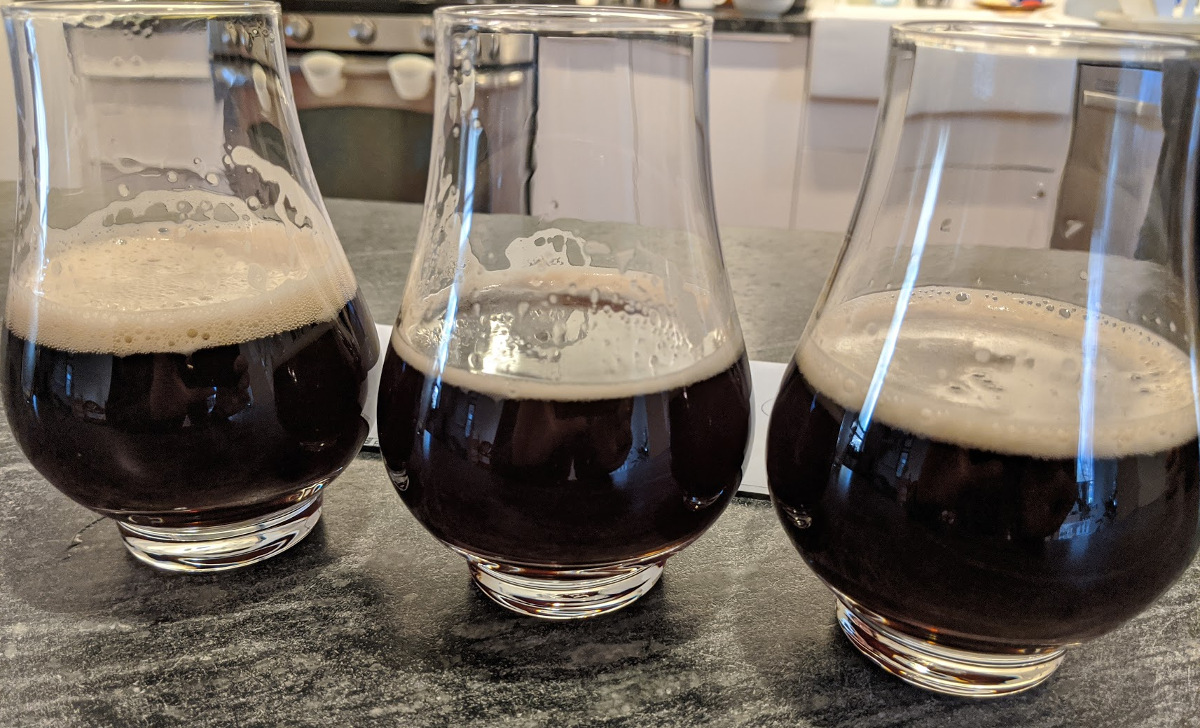
The second beer to go into my 15 gallon Dad’s Hat rye whiskey barrel will be an old ale brewed with black treacle.
Old ale is a wide ranging style. For this version we’re shooting for ~7% abv (before barrel aging), complexity from black treacle, and not too much residual sugar. I’m hoping this all plays nicely with the gentle contribution from a barrel that’s already held imperial stout for a while.
The inspiration for the recipe comes from a Beer and Brewing article on old ale.
This brew is another collaboration with my friend Adam, brewed on his large Ss Brewtech system.
Recipe
I couldn’t find treacle anywhere locally, but it’s available pretty widely online. From what I’ve read, don’t try subbing molasses. Go for the real stuff.
Batch size: 16.5 gallons
Target OG: 1.070
Target FG: 1.019
Calculated IBU: 53
Grain bill (pounds):
37 US 2-row (94.3%)
0.75 Special B (1.9%)
0.75 Black Patent (1.9%)
0.75 Caramunich (1.9%)
Other Fementables:
1.5lb Lyle's Black Treacle added at beginning of boil.
Water:
Baltimore County MD tap water
+ a campden tablet to remove chlorine
Mash:
154 °F @ 1.25 qts/lb (limited by mash tun size)
Then sparge to total pre-boil volume of 18.6 gallons
Hops:
3.7 oz Nugget @ 60 minutes
Yeast:
A large starter of Imperial Pub Ale A09
Fermentation temp 66 °F
Notes
2019-12-13 - Brew day. Pre boil gravity was a little low. Compensated with about 2.75lb of DME. OG 1.073
2020-01-04 - Put the old ale into the barrel immediately once we siphoned out the stout. Gravity is as 1.018
2020-02-08 - Packaging time. The gravity has dropped suspiciously low: 1.009. It’s possible that might just be from the whiskey, but if so, this barrel had a lot more whiskey in it than I was expecting. Might be infected. We’ll just have to wait and see.
Adam and I each filled a keg. Then we bottled the last 5 gallons. Half of the bottles were bottled traditionally, the other half got a light sprinkling of potassium metabisulfite as an experiment to see how that would impact the aging (hopefully reducing oxidization and increasing shelf life)
2020-03-30 - Tasting time.
This one is a winner! The barrel character is subtle but present. It has a satisfying complexity. I’m happy to have so much of this one. I hope the bottles will hold up for years to come.
The carbonation level is nice. A lot lower than the stout.

I lined up a semi-blind test of all three versions of this beer: kegged, standard bottles, and bottles with sulfite. For the life of me, I couldn’t tell them apart. I was sure the bottled ones would taste different from the keg, but even once I knew which was which, they all tasted the same to me.
I’ll repeat this tasting around the 1 year mark and see if any changes develop.
2020-05-12 - Opened a bottle of this for comparison to the stout which is having over-carbonation issues. The old ale poured great. Nice low carbonation like my original tasting. Saved a bit of a bottle to take a gravity reading: 1.008. I got 1.009 at bottling time. I think that’s within my margin of measuring error. I’ll call it unchanged for now.
2021-02-06 - The keg was a bit overcarbonated when I hooked it back up earlier in the winter. It also seemed a bit drier and thinner mouthfeel than I remembered. Still drinkable but not as good as it was fresh. My favorite way to drink it lately has been to blend in the glass with some oatmeal stout
Tried another tasting panel with the bottled versions today. The bottles also taste thin and a bit oxidized. Bottle carbonation is elevated but still reasonable. I think that’s probably just because I primed it so low at bottling.
Warmed up and degassed a bottle sample. Gravity is 1.005. Definitely a mild infection going on.
Changes for next time
I’d like a little higher gravity, higher mash temp, and more time in the barrel.
And for all clean barrel aged beers, I wish I could store them cold once they’re finished. No space for that now, but one of these days I’ll get a dedicated beer fridge.
One way around this might be to hit heavily with sulfites after aging, and then bottle with fresh yeast.